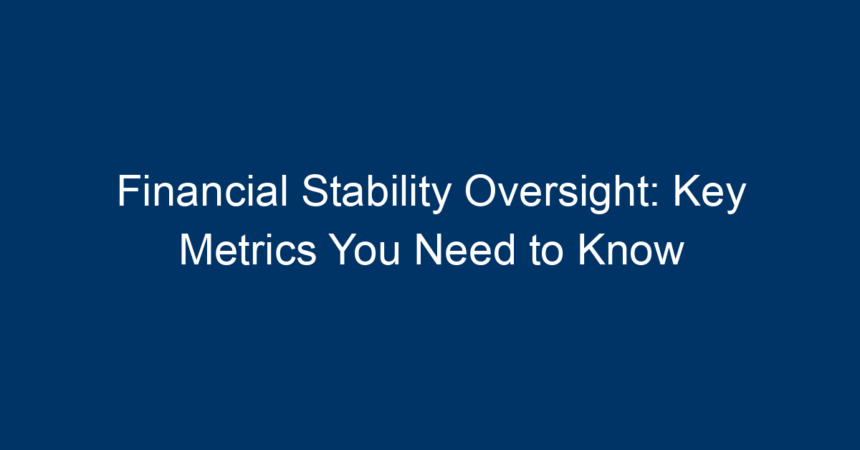In an increasingly interconnected global economy, the stability of financial systems is paramount. Understanding financial stability oversight is essential for policymakers, investors, and institutions, as it serves as a bulwark against potential economic crises. This article delves into the vital metrics necessary for assessing financial stability, ensuring that individuals and organizations can take informed decisions in this complex landscape.
What is Financial Stability Oversight?
Financial stability oversight involves monitoring, assessing, and mitigating risks within the financial system. It aims to prevent systemic crises that could lead to severe economic downturns, employing various tools and metrics to evaluate the resilience of financial institutions and markets.
Key Agencies Involved
In the United States, institutions such as the Financial Stability Oversight Council (FSOC), the Federal Reserve, and the Office of Financial Research play pivotal roles in overseeing financial stability. These agencies analyze various indicators that signal potential instability, making their functions critical to national and international economic health.
Key Metrics for Assessing Financial Stability
Monitoring financial stability requires a comprehensive understanding of several key metrics. Here’s a closer look at these critical indicators:
1. Systemic Risk Indicator (SRI)
The Systemic Risk Indicator quantifies the potential for systemic crises by evaluating the interconnections among major financial institutions.
- Calculation and Importance: The SRI combines various financial metrics, such as leverage ratios and liquidity levels, to create a holistic view of systemic risk.
- Use Case: A rising SRI signals heightened risk, alerting institutions and regulators to take preventive measures.
2. Leverage Ratio
The leverage ratio measures the proportion of a bank’s capital to its assets, giving insight into its solvency and resilience.
- Thresholds of Safety: A higher leverage ratio indicates a bank’s ability to withstand significant losses without defaulting.
- Regulatory Standards: The Basel III framework recommended a minimum leverage ratio of 3%, guiding financial institutions in maintaining healthy capital levels.
3. Liquidity Coverage Ratio (LCR)
The LCR assesses a bank’s ability to meet its short-term obligations during financial stress.
- Components of LCR: It measures the high-quality liquid assets available against total net cash flows over a 30-day period.
- Significance: A sound LCR of 100% or more suggests that a bank can withstand liquidity shocks, bolstering overall financial stability.
4. Net Stable Funding Ratio (NSFR)
While the LCR focuses on short-term liquidity, the NSFR assesses the stability of a bank’s funding profile over a longer horizon.
- Long-Term Perspective: The NSFR compares available stable funding to required stable funding, ensuring that institutions have adequate resources to support long-term assets.
- Regulatory Benchmark: A ratio of at least 100% is deemed necessary to promote sustainability in financing practices.
5. Capital Adequacy Ratio (CAR)
The CAR evaluates a bank’s capital in relation to its risk-weighted assets, providing a measure of financial strength.
- Risk Management: Beyond just capital, regulators look at the different types of risk a bank is exposed to, including credit, market, and operational risks.
- Monitoring Solvency: A higher CAR not only bolsters confidence in a bank’s stability but also aligns with regulatory standards set under Basel III.
6. Economic Indicators
Economic metrics, such as GDP growth rates, unemployment rates, and inflation, also signal the health of the financial system.
- Link to Stability: For instance, chronic unemployment can lead to higher default rates on loans, threatening bank stability and overall economic health.
- Holistic Approach: Monitoring these indicators allows for an understanding of how macroeconomic conditions impact financial systems.
The Role of Stress Testing
Stress tests simulate adverse economic scenarios to assess the resilience of major financial institutions.
- Types of Scenarios: These scenarios include sharp increases in unemployment rates, drastic drops in real estate values, or significant equity market declines.
- Outcome Utilization: The results help policymakers and regulators determine whether institutions need additional capital or may take preemptive measures to ensure stability.
Challenges in Financial Stability Oversight
While the measures outlined above are crucial for maintaining financial stability, they are not without challenges.
1. Data Quality and Availability
High-quality, timely data is essential for accurate assessments, but it can be scant in emerging economies or during crises.
2. Regulatory Divergence
Different countries may have varying standards for financial stability metrics, hindering the ability to gauge systemic risks on a global scale.
3. Market Behavior
The reaction of financial markets to regulatory changes can be unpredictable, complicating efforts to curb excessive risk-taking.
Best Practices for Enhanced Financial Stability
To strengthen financial stability oversight, several best practices can be implemented:
1. Comprehensive Data Sharing
Encouraging collaboration between financial institutions and regulatory bodies can result in better data sharing, leading to more informed decisions.
2. Continuous Monitoring
Implementing a real-time monitoring system for key metrics can help regulators and institutions stay ahead of potential issues, allowing for timely interventions.
3. Public Awareness Campaigns
Increasing public awareness regarding financial practices and stability can lead to more informed decision-making by consumers and investors alike.
4. Global Cooperation
Cross-border regulatory cooperation can streamline responses to global economic threats, enhancing financial stability on a broader level.
Conclusion: Actionable Insights for Stakeholders
In conclusion, financial stability oversight is not just a regulatory function but a foundational component of a healthy economy. By understanding the key metrics—such as the Systemic Risk Indicator, leverage ratio, liquidity ratios, and capital adequacy—stakeholders can better navigate the complexities of financial markets.
For policymakers, continuous data monitoring and fostering global cooperation are essential for effective oversight. For investors and institutions, awareness of these metrics can enhance strategic decision-making, promoting personal and systemic financial health.
Taking proactive measures today can substantially mitigate risks tomorrow, reinforcing the need for robust financial stability oversight in a rapidly evolving financial landscape. Stay informed, stay prepared, and contribute to a more stable economic future.



